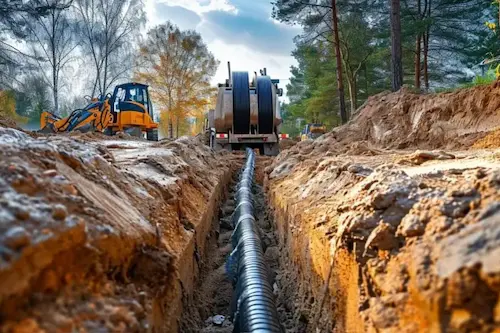The Role of Fiber Optics in Modernizing Underground Utility Construction

We recognize the transformative impact that fiber optics have on modernizing underground utility construction.
Fiber optic technology, once a niche component, is now a cornerstone in enhancing utility infrastructure’s efficiency, reliability, and safety.
This article delves into how fiber optics revolutionize underground utility projects, improving both these systems’ operational aspects and long-term sustainability.
1. Enhanced Communication and Monitoring
Fiber optics offer unparalleled advantages in communication and monitoring for underground utilities. Traditional copper wiring, prone to signal degradation and electromagnetic interference, cannot match fiber optics’ performance. Fiber optic cables transmit data using light signals, which means they are immune to electrical interference and capable of maintaining high-speed communication over long distances.
In our projects We integrate fiber optics to facilitate real-time monitoring and control of underground systems. This capability is crucial for detecting leaks or blockages in water mains and sewer systems. With fiber optics, we can deploy sensors that continuously feed data back to a central monitoring station, allowing for immediate response to potential problems. This proactive approach minimizes downtime and extends the lifespan of utility systems.
2. Improved Data Transmission
One of the most significant benefits of fiber optics in underground utility construction is their superior data transmission capabilities. Fiber optic cables offer high bandwidth, which supports the transfer of vast amounts of data at lightning-fast speeds. This is particularly important for modern utility systems that rely on extensive data collection and analysis for optimal operation.
We use fiber optics to support advanced analytics and data processing for our utility projects. For example, we incorporated fiber optic cables to connect various sensors and monitoring devices in a recent sewer system installation. The result was a highly efficient system that provided detailed insights into the sewer network’s performance, enabling us to make data-driven decisions and improvements.
3. Enhanced Reliability and Durability
Fiber optics are renowned for their durability and reliability, which are essential attributes for underground installations. Unlike copper cables, fiber optic cables are not susceptible to corrosion, which makes them well-suited for harsh underground environments. Their resilience to temperature fluctuations and physical stress further enhances their suitability for use in utility construction.
In our work We prioritize using fiber optics to ensure our underground utility systems remain reliable and robust. Fiber optic cables can withstand the conditions commonly found in underground settings, such as moisture and soil pressure. This durability translates to fewer maintenance issues and a more dependable utility infrastructure, which benefits both the operators and the end-users of these systems.
4. Facilitating Smart Infrastructure
Integrating fiber optics into underground utility construction is a crucial enabler of intelligent infrastructure. Smart infrastructure refers to systems that use advanced technologies, including sensors and data analytics, to enhance performance and efficiency. Fiber optics play a crucial role in this context by providing high-speed, high-capacity communication channels to support intelligent technologies.
Milidaro leverages fiber optics to develop and deploy intelligent utility solutions. For instance, we use fiber optic networks to connect smart sensors and control systems that manage water distribution and sewer flow. These smart-systems can automatically adjust to changing conditions, optimize resource usage, and provide valuable insights into system performance. By incorporating fiber optics, we enhance the capability of these intelligent systems to operate seamlessly and effectively.
5. Cost-Effective Solution
Although fiber optics represent an initial investment, they offer long-term cost benefits that make them a cost-effective choice for underground utility construction. Their high performance and reliability reduce the need for frequent repairs and replacements, which can be costly in the long run. Additionally, fiber optics’ improved data transmission and monitoring capabilities lead to more efficient operations and resource management.
We assess the cost-benefit ratio of incorporating fiber optics into our projects and consistently find that the advantages far outweigh the initial costs. Fiber optics’ enhanced performance, durability, and data capabilities contribute to lower overall maintenance costs and improved system efficiency.
6. Future-Proofing Utility Infrastructure
In an era of rapid technological advancements, future-proofing infrastructure is critical. Fiber optics offer a future-proof solution for underground utility construction by supporting the latest technologies and accommodating future upgrades. As utility systems evolve to incorporate new technologies and demands, fiber optics provide the scalability and flexibility needed to adapt to these changes.
Milidaro is committed to integrating fiber optics into our projects to ensure our utility infrastructure remains relevant and adaptable. By choosing fiber optics, we future-proof our systems and provide a solid foundation for integrating emerging technologies and innovations.
Fiber optics are pivotal in modernizing underground utility construction, offering significant benefits in communication, data transmission, reliability, and cost-effectiveness. We harness the power of fiber optics to enhance the performance and sustainability of our utility projects, ensuring that our infrastructure meets the demands of today and the future.
